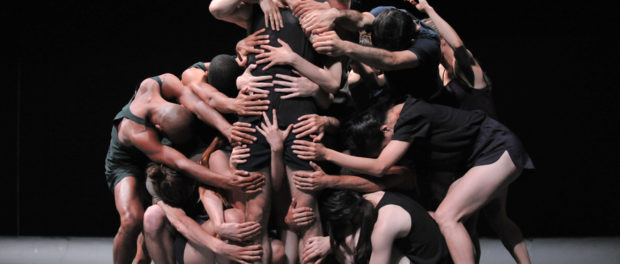Ohad Naharin’s “Last Work”: Mind. Blown.
Presented as part of this year’s Danse Danse Season, Ohad Naharin’s new piece, “Last Work,” opens with a solitary runner, a woman in a blue dress and sneakers, hair tied back in a ponytail, running in place towards the back of the stage. For the entire 80-minute show, the woman runs on an invisible treadmill, her pace and position on stage never changing: a steady pulse, a heartbeat, a ticking bomb.
After a few minutes, a man emerges from the wings, crouching, moving forward while dragging one hand on the ground, using only the strength of his thighs to propel himself. The effect is somewhat Neanderthal. The contrast between the runner’s upright propulsion and his slouching, fluid motions is striking.
The first third of “Last Work,” choreographed for Naharin’s Israel-based Batsheva Dance Company, seems to be modern dance par excellence: dance about dance, an abstract exploration of bodies in motion. Body parts are isolated and inscribe circles and shapes that alternate between amphibian and bird-like. Thighs propel upper bodies through extremely low stances, occasionally lengthening in stork-like motion. The effect is primal and disquieting and often strangely erotic: a Hieronymous Bosch painting sprung to life.
And all the while the running woman runs: sometimes we are acutely aware of her, other times she is lost behind the mass of dancers.
In the middle section of the work, the dancers change at the back of the stage into new costumes. Many of the men are now in what appear to be monk’s robes, while the women wear white shorts and tank tops; one woman wears a frilly tutu. This part of the work is more explicitly sexual, often animalistic, disturbing. Couples simulate frenzied copulation and oral sex; some weird stuff goes down with the monks; the woman in the tutu crawls like an animal in heat.
The runner continues running.
In the last part of the piece the energy explodes. All the dancers emerge in white cloth masks, recalling, to my mind, the horrifying images from Abu Ghraib. Eventually most of the masks come off. Everyone gathers in front of the runner, and one by one they break into repetitive, mechanical motions, like parts of a clock, but a Dali-esque melting clock. Bodies slouch sideways then jerk back up again. A wild hora-like dance eventually breaks out, while at the back of the stage, in line with the runner, a man in a mask waves a white flag; another swings a large, wooden, rather medieval-looking noisemaker around and around, like something you’d see at an S&M Purim celebration, a third sits with his back to the audience vibrating endlessly—is he operating a jackhammer? Or furiously masturbating?—while a fourth sets up a microphone and starts maniacally shouting while wrapping packing tape around it and taping it first to the ground, then to all the dancers who are by this time spread out across the stage. Sometime during this over-the-top finale the vibrating man turns around and we see that he is frenziedly polishing a machine gun. When all the dancers have been tied up and together by the crazy tape man, they collapse on the floor. The noisemaker stops, the rifle-masturbator stops, the taping man stops, and the masked man takes his white flag and passes it to the runner, who keeps running, bearing the white flag of surrender aloft. The dancers are now dressed in the colours of the Israeli flag—the runner in blue, the rest in white—and we are jolted by the realization that there is a political statement here, that this isn’t purely abstract movement after all. But I would hazard a guess that the political intent may be to simply reveal what it means to be human and alive and in motion: we are animals, we move in the elements of nature, be they physical or psychological, external or internal. Religion, politics, sex: we have no choice but to keep running and surrender to the absurdity of being alive.






